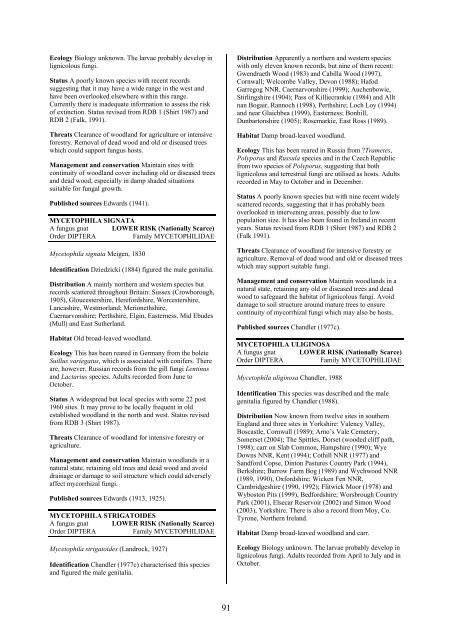Part 2: Nematocera and Aschiza not dealt with by Falk (1991) - JNCC
Part 2: Nematocera and Aschiza not dealt with by Falk (1991) - JNCC
Part 2: Nematocera and Aschiza not dealt with by Falk (1991) - JNCC
You also want an ePaper? Increase the reach of your titles
YUMPU automatically turns print PDFs into web optimized ePapers that Google loves.
Ecology Biology unknown. The larvae probably develop in<br />
lignicolous fungi.<br />
Status A poorly known species <strong>with</strong> recent records<br />
suggesting that it may have a wide range in the west <strong>and</strong><br />
have been overlooked elsewhere <strong>with</strong>in this range.<br />
Currently there is inadequate information to assess the risk<br />
of extinction. Status revised from RDB 1 (Shirt 1987) <strong>and</strong><br />
RDB 2 (<strong>Falk</strong>, <strong>1991</strong>).<br />
Threats Clearance of woodl<strong>and</strong> for agriculture or intensive<br />
forestry. Removal of dead wood <strong>and</strong> old or diseased trees<br />
which could support fungus hosts.<br />
Management <strong>and</strong> conservation Maintain sites <strong>with</strong><br />
continuity of woodl<strong>and</strong> cover including old or diseased trees<br />
<strong>and</strong> dead wood, especially in damp shaded situations<br />
suitable for fungal growth.<br />
Published sources Edwards (1941).<br />
MYCETOPHILA SIGNATA<br />
A fungus gnat LOWER RISK (Nationally Scarce)<br />
Order DIPTERA<br />
Family MYCETOPHILIDAE<br />
Mycetophila signata Meigen, 1830<br />
Identification Dziedzicki (1884) figured the male genitalia.<br />
Distribution A mainly northern <strong>and</strong> western species but<br />
records scattered throughout Britain: Sussex (Crowborough,<br />
1905), Gloucestershire, Herefordshire, Worcestershire,<br />
Lancashire, Westmorl<strong>and</strong>; Merionethshire,<br />
Caernarvonshire; Perthshire, Elgin, Easterness. Mid Ebudes<br />
(Mull) <strong>and</strong> East Sutherl<strong>and</strong>.<br />
Habitat Old broad-leaved woodl<strong>and</strong>.<br />
Ecology This has been reared in Germany from the bolete<br />
Suillus variegatus, which is associated <strong>with</strong> conifers. There<br />
are, however, Russian records from the gill fungi Lentinus<br />
<strong>and</strong> Lactarius species. Adults recorded from June to<br />
October.<br />
Status A widespread but local species <strong>with</strong> some 22 post<br />
1960 sites. It may prove to be locally frequent in old<br />
established woodl<strong>and</strong> in the north <strong>and</strong> west. Status revised<br />
from RDB 3 (Shirt 1987).<br />
Threats Clearance of woodl<strong>and</strong> for intensive forestry or<br />
agriculture.<br />
Management <strong>and</strong> conservation Maintain woodl<strong>and</strong>s in a<br />
natural state, retaining old trees <strong>and</strong> dead wood <strong>and</strong> avoid<br />
drainage or damage to soil structure which could adversely<br />
affect mycorrhizal fungi.<br />
Published sources Edwards (1913, 1925).<br />
MYCETOPHILA STRIGATOIDES<br />
A fungus gnat LOWER RISK (Nationally Scarce)<br />
Order DIPTERA<br />
Family MYCETOPHILIDAE<br />
Mycetophila strigatoides (L<strong>and</strong>rock, 1927)<br />
Identification Ch<strong>and</strong>ler (1977c) characterised this species<br />
<strong>and</strong> figured the male genitalia.<br />
Distribution Apparently a northern <strong>and</strong> western species<br />
<strong>with</strong> only eleven known records, but nine of them recent:<br />
Gwendraeth Wood (1983) <strong>and</strong> Cabilla Wood (1997),<br />
Cornwall; Welcombe Valley, Devon (1988); Hafod<br />
Garregog NNR, Caernarvonshire (1999); Auchenbowie,<br />
Stirlingshire (1904); Pass of Killiecrankie (1984) <strong>and</strong> Allt<br />
nan Bogair, Rannoch (1998), Perthshire; Loch Loy (1994)<br />
<strong>and</strong> near Glaichbea (1999), Easterness; Bonhill,<br />
Dunbartonshire (1905); Rosemarkie, East Ross (1989).<br />
Habitat Damp broad-leaved woodl<strong>and</strong>.<br />
Ecology This has been reared in Russia from ?Trametes,<br />
Polyporus <strong>and</strong> Russula species <strong>and</strong> in the Czech Republic<br />
from two species of Polyporus, suggesting that both<br />
lignicolous <strong>and</strong> terrestrial fungi are utilised as hosts. Adults<br />
recorded in May to October <strong>and</strong> in December.<br />
Status A poorly known species but <strong>with</strong> nine recent widely<br />
scattered records, suggesting that it has probably been<br />
overlooked in intervening areas, possibly due to low<br />
population size. It has also been found in Irel<strong>and</strong> in recent<br />
years. Status revised from RDB 1 (Shirt 1987) <strong>and</strong> RDB 2<br />
(<strong>Falk</strong> <strong>1991</strong>).<br />
Threats Clearance of woodl<strong>and</strong> for intensive forestry or<br />
agriculture. Removal of dead wood <strong>and</strong> old or diseased trees<br />
which may support suitable fungi.<br />
Management <strong>and</strong> conservation Maintain woodl<strong>and</strong>s in a<br />
natural state, retaining any old or diseased trees <strong>and</strong> dead<br />
wood to safeguard the habitat of lignicolous fungi. Avoid<br />
damage to soil structure around mature trees to ensure<br />
continuity of mycorrhizal fungi which may also be hosts.<br />
Published sources Ch<strong>and</strong>ler (1977c).<br />
MYCETOPHILA ULIGINOSA<br />
A fungus gnat LOWER RISK (Nationally Scarce)<br />
Order DIPTERA<br />
Family MYCETOPHILIDAE<br />
Mycetophila uliginosa Ch<strong>and</strong>ler, 1988<br />
Identification This species was described <strong>and</strong> the male<br />
genitalia figured <strong>by</strong> Ch<strong>and</strong>ler (1988).<br />
Distribution Now known from twelve sites in southern<br />
Engl<strong>and</strong> <strong>and</strong> three sites in Yorkshire: Valency Valley,<br />
Boscastle, Cornwall (1989); Arno’s Vale Cemetery,<br />
Somerset (2004); The Spittles, Dorset (wooded cliff path,<br />
1998); carr on Slab Common, Hampshire (1990); Wye<br />
Downs NNR, Kent (1994); Cothill NNR (1977) <strong>and</strong><br />
S<strong>and</strong>ford Copse, Dinton Pastures Country Park (1994),<br />
Berkshire; Barrow Farm Bog (1989) <strong>and</strong> Wychwood NNR<br />
(1989, 1990), Oxfordshire; Wicken Fen NNR,<br />
Cambridgeshire (1990, 1992); Flitwick Moor (1978) <strong>and</strong><br />
Wyboston Pits (1999), Bedfordshire; Worsbrough Country<br />
Park (2001), Elsecar Reservoir (2002) <strong>and</strong> Simon Wood<br />
(2003), Yorkshire. There is also a record from Moy, Co.<br />
Tyrone, Northern Irel<strong>and</strong>.<br />
Habitat Damp broad-leaved woodl<strong>and</strong> <strong>and</strong> carr.<br />
Ecology Biology unknown. The larvae probably develop in<br />
lignicolous fungi. Adults recorded from April to July <strong>and</strong> in<br />
October.<br />
91
















